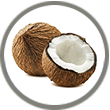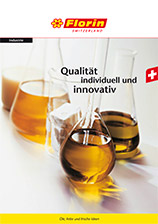Every individual production step is performed and tested on the basis of our IFS-certified (higher level) and ISO 90012000-certified quality assurance system.
All vegetable oils and fats come from traditional cultivation. We do not use genetically modified starting materials and only obtain our oils by heating and pressing.
The demands placed on our products are as versatile as their fields of use. This allows us to develop high-grade margarines and fats for the most diverse end products for our customers in the food industry. The type of refining, whether selective hardening, fractionation or transesterification, essentially depends on the individual problem.
As a specialist in the production of vegetable edible oils, you're guaranteed to find a comprehensive selection of pure oils and oil blends for the most varied cooking temperatures and uses from Florin.
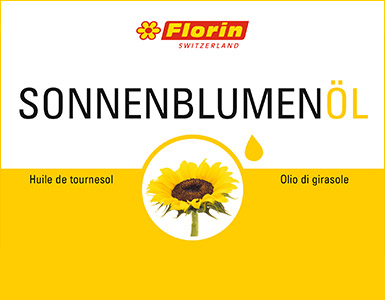
| Energy 3700 kJ (900 kcal) | |
| Protein | 0 g |
| Carbohydrates | 0 g |
| Fat | 100 g |
| Saturated fatty acids | 11 g |
| Monounsaturated fatty acids | 28 g |
| Polyunsaturated fatty acids | 60 g |
| Trans-fatty acids | 0 g |
| Cholesterol | 0 mg |
Sunflower oil is rich in natural vitamin E and polyunsaturated fatty acids (linoleic acid 63%). This makes it especially valuable for cold food and it is ideal for preparing fine salads and mayonnaise. Like wheat germ oil, it is also used as a dietetic food and is even used in the pharmaceutical industry as a filler for soft gel capsules and for the production of ointments and creams. By contrast, high oleic sunflower oil has three times as many monounsaturated fatty acids and can be heated to a high temperature.
Sunflower seeds are harvested from the end of September through to the end of October with a grain humidity of 10 - 12% water content. The 10 to 40 cm wide sunflower heads each contain up to 2000 seeds from which oil is obtained. These seed kernels are each around 1.7 cm long and, depending on the variety, vary in colour from black to whitish or black and white striped. The oil content is around 34% with unshelled seeds and up to 63% with shelled seeds.
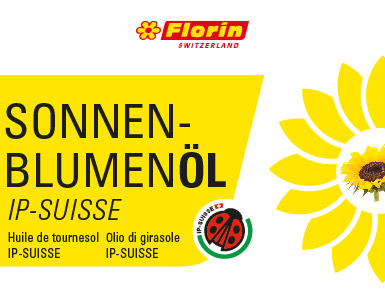
| Energy 3700 kJ (900 kcal) | |
| Protein | 0 g |
| Carbohydrates | 0 g |
| Fat | 100 g |
| Saturated fatty acids | 11 g |
| Monounsaturated fatty acids | 28 g |
| Polyunsaturated fatty acids | 60 g |
| Trans-fatty acids | 0 g |
| Cholesterol | 0 mg |
Sunflower IP-SUISSE oil is rich in natural vitamin E and polyunsaturated fatty acids (linoleic acid 63%). This makes it especially valuable for cold food and it is ideal for preparing fine salads and mayonnaise. Like wheat germ oil, it is also used as a dietetic food and is even used in the pharmaceutical industry as a filler for soft gel capsules and for the production of ointments and creams. By contrast, high oleic sunflower oil has three times as many monounsaturated fatty acids and can be heated to a high temperature.
Sunflower seeds are harvested from the end of September through to the end of October with a grain humidity of 10 - 12% water content. The 10 to 40 cm wide sunflower heads each contain up to 2000 seeds from which oil is obtained. These seed kernels are each around 1.7 cm long and, depending on the variety, vary in colour from black to whitish or black and white striped. The oil content is around 34% with unshelled seeds and up to 63% with shelled seeds.
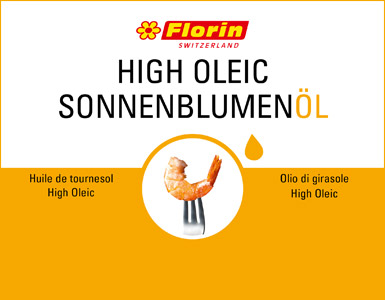
| Energy 3700 kJ (900 kcal) | |
| Protein | 0 g |
| Carbohydrates | 0 g |
| Fat | 100 g |
| Saturated fatty acids | 8 g |
| Monounsaturated fatty acids | 83 g |
| Polyunsaturated fatty acids | 8 g |
| Trans-fatty acids | 0 g |
| Cholesterol | 0 mg |
High oleic sunflower oil, as its name suggests, contains a high proportion of monounsaturated oleic acid. It is also rich in natural vitamin E and, thanks to its fatty acid composition, is especially good for deep-frying (very pleasant smell).
By the natural hybridisation of different varieties, it has been possible to produce a "high oleic sunflower" from which this fine vegetable oil is obtained. As with normal sunflower oil, these plants are harvested from the end of September to the end of October with a grain humidity of 10 - 12% moisture content. The oil content is around 34% with unshelled seeds and up to 63% with shelled seeds.
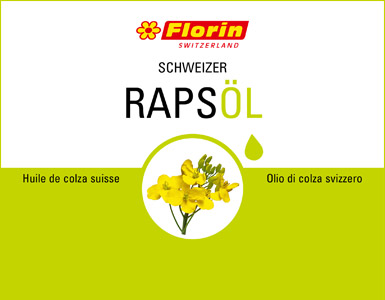
| Energy 3700 kJ (900 kcal) | |
| Protein | 0 g |
| Carbohydrates | 0 g |
| Fat | 100 g |
| Saturated fatty acids | 8 g |
| Monounsaturated fatty acids | 65 g |
| Polyunsaturated fatty acids | 26 g |
| Trans-fatty acids | 0 g |
| Cholesterol | 0 mg |
Thanks to its unique fatty acid composition, rapeseed oil is one of the most valuable edible oils from Swiss production. It contains natural vitamin E and is the only oil, that we commonly use, that contains significant quantities of linolenic acid.
These polyunsaturated fatty acids (including linoleic acid) have a positive effect on the metabolism and especially on the cholesterol level.
According to the latest studies, monounsaturated fatty acids also have a positive impact providing they are capable of substituting fatty acids in food (lowers LDL cholesterol).
Rapeseed oil is also said to have a stabilising effect on the blood. It is particularly suitable for cold and hot cooking (not for deep-frying)
Florin AG preferentially processes rapeseed that carries the Suisse Garantie seal of origin.
If the domestic harvest is inadequate, Florin AG also procures imported rapeseed to ensure security of supply. There are around 6,500 rapeseed producers in Switzerland. 1/3 of the cultivated area is used for HOLL rapeseed, and 2/3 for conventional rapeseed. Winter rape is predominantly cultivated, which is planted in August, before the winter. Rape flowers in April or May. As soon as the flowers have been fertilised, they form pods, in which many small black kernels are to be found – the rapeseed. Rape is harvested from mid-July onwards.
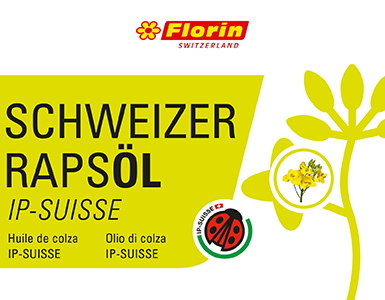
| Energy 3700 kJ (900 kcal) | |
| Protein | 0 g |
| Carbohydrates | 0 g |
| Fat | 100 g |
| Saturated fatty acids | 8 g |
| Monounsaturated fatty acids | 65 g |
| Polyunsaturated fatty acids | 26 g |
| Trans-fatty acids | 0 g |
| Cholesterol | 0 mg |
Thanks to its unique fatty acid composition, rapeseed oil IP-SUISSE is one of the most valuable edible oils from Swiss production. It contains natural vitamin E and is the only oil, that we commonly use, that contains significant quantities of linolenic acid.
These polyunsaturated fatty acids (including linoleic acid) have a positive effect on the metabolism and especially on the cholesterol level.
According to the latest studies, monounsaturated fatty acids also have a positive impact providing they are capable of substituting fatty acids in food (lowers LDL cholesterol).
Rapeseed oil is also said to have a stabilising effect on the blood. It is particularly suitable for cold and hot cooking (not for deep-frying)
Florin AG preferentially processes rapeseed that carries the Suisse Garantie seal of origin.
If the domestic harvest is inadequate, Florin AG also procures imported rapeseed to ensure security of supply. There are around 6,500 rapeseed producers in Switzerland. 1/3 of the cultivated area is used for HOLL rapeseed, and 2/3 for conventional rapeseed. Winter rape is predominantly cultivated, which is planted in August, before the winter. Rape flowers in April or May. As soon as the flowers have been fertilised, they form pods, in which many small black kernels are to be found – the rapeseed. Rape is harvested from mid-July onwards.
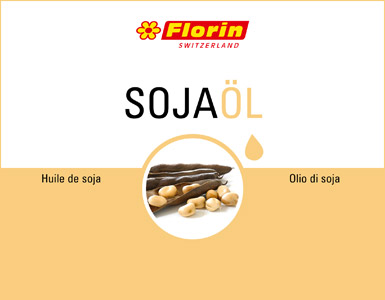
| Energy 3700 kJ (900 kcal) | |
| Protein | 0 g |
| Carbohydrates | 0 g |
| Fat | 100 g |
| Saturated fatty acids | 15 g |
| Monounsaturated fatty acids | 26 g |
| Polyunsaturated fatty acids | 58 g |
| Trans-fatty acids | 0 g |
| Cholesterol | 0 mg |
Soya oil contains natural vitamin E and is rich in polyunsaturated fatty acids with over 50% linoleic acid (double unsaturated) and approx. 6% alpha-linolenic acid (triple unsaturated). The latter is an essential nutrient and has an anti-inflammatory effect. Soya oil is similar to rapeseed oil in the composition of its fatty acids.
Soya beans grow on bushes up to a height of around one metre. The plant needs a lot of sun and long nights to convert energy into oil and protein. When ripe, the fields have a yellowish brown colour, as the leaves dry and fall off. Only the stalks, stems and pods remain on the plants. The yellow, grey or brownish-black pods are hairy and contain up to five seeds, which vary in shape, size and colour, depending on the type. However, generally they are cream in colour. Green, red or black seeds are offered more rarely on the market. The harvesting time is very varied and is dependent on the weather conditions and bean-growing region. In Western Europe, soya beans are generally harvested from September to October.
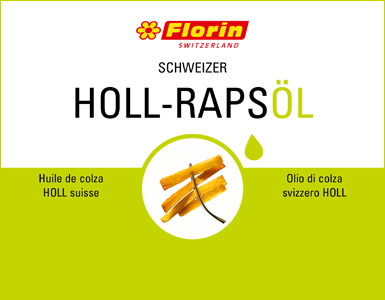
| Energy 3700 kJ (900 kcal) | |
| Protein | 0 g |
| Carbohydrates | 0 g |
| Fat | 100 g |
| Saturated fatty acids | 6 g |
| Monounsaturated fatty acids | 79 g |
| Polyunsaturated fatty acids | 14 g |
| Trans-fatty acids | 0 g |
| Cholesterol | 0 mg |
HOLL rapeseed oil is perfect for deep-frying and shallow frying. This natural cultivation also guarantees stability at high temperatures. Correspondingly, the HOLL rapeseed oil obtained from it is unhydrogenated and contains practically no trans-fatty acids. Thanks to its unique fatty acid composition, HOLL rapeseed oil is one of the most valuable edible oils from Swiss production. It contains natural vitamin E and is the only oil, that we commonly use, that contains significant quantities of linolenic acid.
The polyunsaturated fatty acids (including linoleic acid) have a positive effect on the metabolism and especially on the cholesterol level.
Monounsaturated fatty acids also have a positive impact providing they are capable of substituting fatty acids in food (lowers LDL cholesterol).
Florin AG only processes HOLL rape seeds that carry the "Suisse Garantie" mark of origin -> hier sollten wir Link zu Vertiefung swiss garantie setzen. There are around 6,500 rapeseed producers in Switzerland. 1/3 of the cultivated area is used for HOLL rapeseed, and 2/3 for conventional rapeseed. Winter rape is predominantly cultivated, which is planted in August, before the winter. Rape flowers in April or May. As soon as the flowers have been fertilised, they form pods, in which many small black kernels are to be found – the rapeseed. Rape is harvested from mid-July onwards.
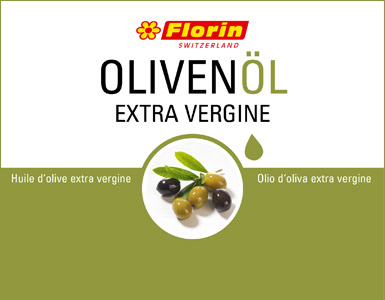
| Energy 3700 kJ (900 kcal) | |
| Protein | 0 g |
| Carbohydrates | 0 g |
| Fat | 100 g |
| Saturated fatty acids | 13 g |
| Monounsaturated fatty acids | 79 g |
| Polyunsaturated fatty acids | 8 g |
| Trans-fatty acids | 0 g |
| Cholesterol | 0 mg |
Ultra-fine, cold-pressed olive oil for all Mediterranean dishes. The nutritive tissue of the fruit flesh has an oil content of between 50% and 56%. The linoleic content is 8% and it also contains natural vitamin E.
Olive trees are grown predominantly in the Mediterranean countries in large plantations. The fruit of the olive tree, olives, are the size of grapes and are either dark-green, dark-violet or black, depending on their degree of maturity. The olives themselves are stone fruit with a hard stone. An early harvest by hand and immediate processing of the olives is crucial to produce high-grade olive oil. Harvesting begins during the first days of October and can last until December. Olives are processed in their country of cultivation as they do not tolerate long periods of storage nor long periods of transport.
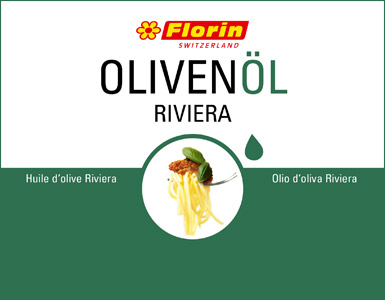
| Energy 3700 kJ (900 kcal) | |
| Protein | 0 g |
| Carbohydrates | 0 g |
| Fat | 100 g |
| Saturated fatty acids | 13 g |
| Monounsaturated fatty acids | 78 g |
| Polyunsaturated fatty acids | 8 g |
| Trans-fatty acids | 0 g |
| Cholesterol | 0 mg |
Very fine olive oil for all Mediterranean dishes. The nutritive tissue of the fruit flesh has an oil content of between 50% and 56%. The linoleic content is 8% and it also contains natural vitamin E.
Olive trees are grown predominantly in the Mediterranean countries in large plantations. The fruit of the olive tree, olives, are the size of grapes and are either dark-green, dark-violet or black, depending on their degree of maturity. The olives themselves are stone fruit with a hard stone. An early harvest by hand and immediate processing of the olives is crucial to produce high-grade olive oil. Harvesting begins during the first days of October and can last until December. Olives are processed in their country of cultivation as they do not tolerate long periods of storage nor long periods of transport.
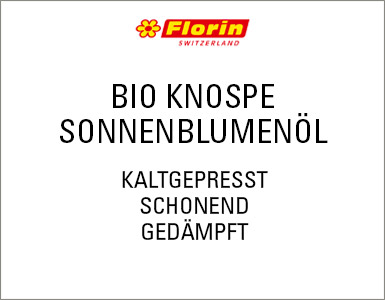
| Energy 3700 kJ (900 kcal) | |
| Protein | 0 g |
| Carbohydrates | 0 g |
| Fat | 100 g |
| Saturated fatty acids | 11 g |
| Monounsaturated fatty acids | 28 g |
| Polyunsaturated fatty acids | 60 g |
| Trans-fatty acids | 0 g |
| Cholesterol | 0 mg |
The gentle process of cold pressing retains more flavours and vitamins, especially the high content of natural vitamin E. The natural, slightly nutty flavour makes this oil the perfect accompaniment to cold food. This product is BIO Bud-certified.
Sunflower seeds are harvested from the end of September through to the end of October with a grain humidity of 10 - 12% water content. The 10 to 40 cm wide sunflower heads each contain up to 2000 seeds from which oil is obtained. These seed kernels are each around 1.7 cm long and, depending on the variety, vary in colour from black to whitish or black and white striped. The oil content is around 34% with unshelled seeds and up to 63% with shelled seeds.
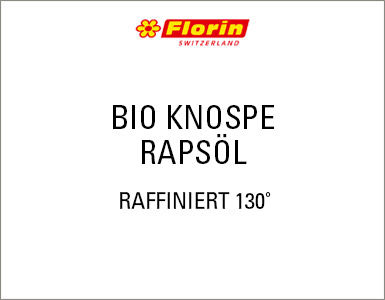
| Energy 3700 kJ (900 kcal) | |
| Protein | 0 g |
| Carbohydrates | 0 g |
| Fat | 100 g |
| Saturated fatty acids | 8 g |
| Monounsaturated fatty acids | 63 g |
| Polyunsaturated fatty acids | 28 g |
| Trans-fatty acids | 0 g |
| Cholesterol | 0 mg |
Thanks to its unique fatty acid composition, rapeseed oil is one of the most valuable edible oils from Swiss production. It contains natural vitamin E and is the only oil, that we commonly use, that contains significant quantities of linolenic acid.
These polyunsaturated fatty acids (including linoleic acid) have a positive effect on the metabolism and especially on the cholesterol level.
According to the latest studies, monounsaturated fatty acids also have a positive impact providing they are capable of substituting fatty acids in food (lowers LDL cholesterol).
Rapeseed oil is also said to have a stabilising effect on the blood. It is particularly suitable for cold and hot cooking (not for deep-frying).
Florin AG only processes rape seeds that carry the "Suisse Garantie" mark of origin -> hier sollten wir Link zu Vertiefung swiss garantie setzen. There are around 6,500 rapeseed producers in Switzerland. 1/3 of the cultivated area is used for HOLL rapeseed, and 2/3 for conventional rapeseed. Winter rape is predominantly cultivated, which is planted in August, before the winter. Rape flowers in April or May. As soon as the flowers have been fertilised, they form pods, in which many small black kernels are to be found – the rapeseed. Rape is harvested from mid-July onwards.
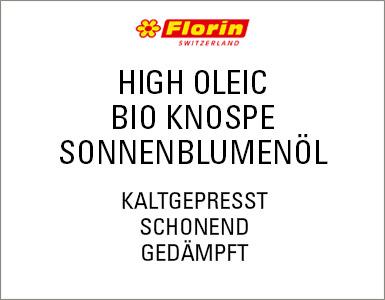
| Energy 3700 kJ (900 kcal) | |
| Protein | 0 g |
| Carbohydrates | 0 g |
| Fat | 100 g |
| Saturated fatty acids | 8 g |
| Monounsaturated fatty acids | 80 g |
| Polyunsaturated fatty acids | 11 g |
| Trans-fatty acids | 0 g |
| Cholesterol | 0 mg |
The combination of High Oleic seeds with gentle cold pressing produces an oil with a high level of oxidation stability
By the natural hybridisation of different varieties, it has been possible to produce a "high oleic sunflower" from which this fine vegetable oil is obtained. As with normal sunflower oil, these plants are harvested from the end of September to the end of October with a grain humidity of 10 - 12% moisture content. The oil content is around 34% with unshelled seeds and up to 63% with shelled seeds.
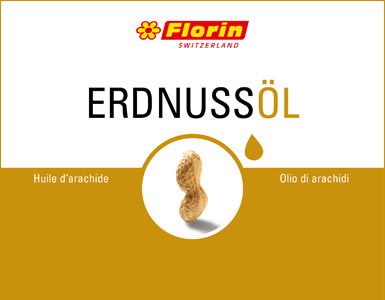
| Energy 3700 kJ (900 kcal) | |
| Protein | 0 g |
| Carbohydrates | 0 g |
| Fat | 100 g |
| Saturated fatty acids | 17 g |
| Monounsaturated fatty acids | 64 g |
| Polyunsaturated fatty acids | 18 g |
| Trans-fatty acids | 0 g |
| Cholesterol | 0 mg |
Peanut oil is rich in mono- and polyunsaturated fatty acids. It is resistant to oxidation and, as such, can be heated to a high temperature and is therefore very suitable for deep-frying and shallow frying. The oil flocculates at temperatures below 13°C but regains its liquidity at higher temperatures without any loss of quality.
The entire plant dries out in autumn. To harvest the nuts, the main root is first separated and then the plant is pulled out of the soil. The leaves and fruit are then dried in the air for 2 to 6 weeks and their moisture level thus drops from 40% to 10%. The peanut oil is obtained by pressing the kernels. It can be heated to a high temperature and is therefore one of the most important edible oils in catering.





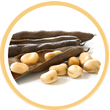

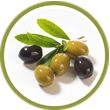





As a margarine producer, your fat and margarine needs are in the best hands with Florin. The following vegetable fats and margarines complete our comprehensive range.
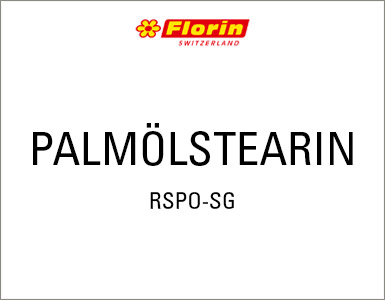
| Energy 3700 kJ (900 kcal) | |
| Protein | 0 g |
| Carbohydrates | 0 g |
| Fat | 100 g |
| Saturated fatty acids | 66 g |
| Monounsaturated fatty acids | 27 g |
| Polyunsaturated fatty acids | 6 g |
| Trans-fatty acids | 0 g |
| Cholesterol | 0 mg |
Palm oil stearin is produced by the physical separation of palm oil into a stearin and an olein phase. Due to its composition, among other things with the saturated fatty acid stearic acid, this fat has a very high melting point.
The fruits of the oil palm are harvested throughout the year.
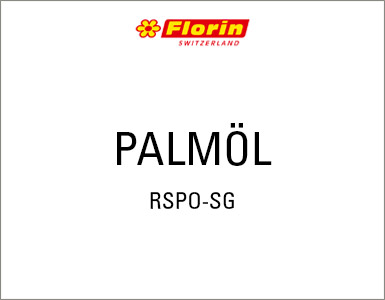
| Energy 3700 kJ (900 kcal) | |
| Protein | 0 g |
| Carbohydrates | 0 g |
| Fat | 100 g |
| Saturated fatty acids | 50 g |
| Monounsaturated fatty acids | 40 g |
| Polyunsaturated fatty acids | 9 g |
| Trans-fatty acids | 0 g |
| Cholesterol | 0 mg |
Palm oil consists largely of saturated and monounsaturated fatty acids and therefore has outstanding stability to heat and oxidation. Its characteristic melting properties enable it to be used in a number of different ways in fat and margarine production. These properties make palm oil a cost-effective substitute for hydrogenated fats.
The fruits of the oil palm are harvested throughout the year.
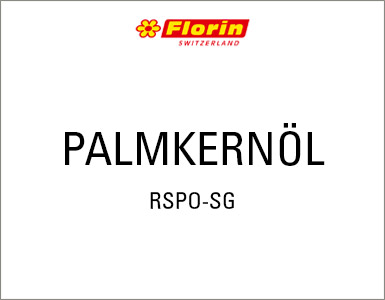
| Energy 3700 kJ (900 kcal) | |
| Protein | 0 g |
| Carbohydrates | 0 g |
| Fat | 100 g |
| Saturated fatty acids | 80 g |
| Monounsaturated fatty acids | 17 g |
| Polyunsaturated fatty acids | 2 g |
| Trans-fatty acids | 0 g |
| Cholesterol | 0 mg |
Palm kernel oil has a very steep melting curve due to its fatty acid composition, which means that it melts very quickly in the mouth and thus has a pleasing cooling effect. This is why palm kernel oil is very often used for cocoa glazes, ice confections, cream coatings and rapidly-melting chocolate fillings.
The fruits of the oil palm are harvested throughout the year. Palm kernel oil is obtained from the inner part of the palm fruit.
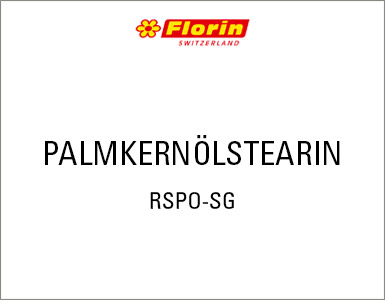
| Energy 0 kJ (0 kcal) | |
| Protein | 0 g |
| Carbohydrates | 0 g |
| Fat | 0 g |
| Saturated fatty acids | 0 g |
| Monounsaturated fatty acids | 0 g |
| Polyunsaturated fatty acids | 0 g |
| Trans-fatty acids | 0 g |
| Cholesterol | 0 mg |
The physical separation of the different fatty acids in palm kernel oil produces a fat with a very high melting point and a very steep melting curve. When it melts in the mouth it produces a very pleasing cooling effect.
The fruits of the oil palm are harvested throughout the year.
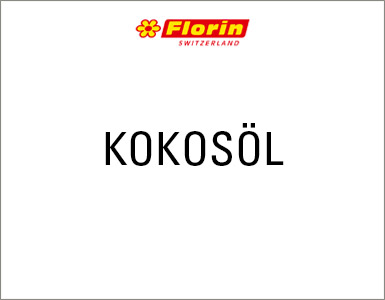
| Energy 3700 kJ (900 kcal) | |
| Protein | 0 g |
| Carbohydrates | 0 g |
| Fat | 100 g |
| Saturated fatty acids | 89 g |
| Monounsaturated fatty acids | 8 g |
| Polyunsaturated fatty acids | 2 g |
| Trans-fatty acids | 0 g |
| Cholesterol | 0 mg |
Coconut oil is white in colour and has a very mild flavour with a slight hint of coconut. As it contains a high percentage of saturated fatty acids, it is solid at room temperature and is ideal for hot cooking, especially baking, frying and deep-frying. When it melts in the mouth it produces a very pleasing cooling effect.
Coconut oil is obtained from coprah. Coprah is harvested all year round.
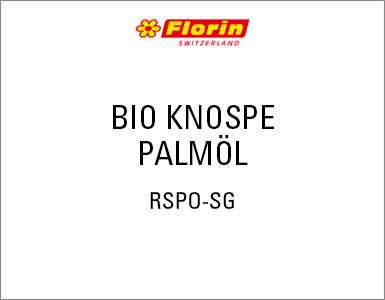
| Energy 3700 kJ (900 kcal) | |
| Protein | 0 g |
| Carbohydrates | 0 g |
| Fat | 100 g |
| Saturated fatty acids | 50 g |
| Monounsaturated fatty acids | 40 g |
| Polyunsaturated fatty acids | 9 g |
| Trans-fatty acids | 0 g |
| Cholesterol | 0 mg |
Palm oil consists largely of saturated and monounsaturated fatty acids and therefore has outstanding stability to heat and oxidation. Its characteristic melting properties enable it to be used in a number of different ways in fat and margarine production. These properties make palm oil a cost-effective substitute for hydrogenated fats.
The fruits of the oil palm are harvested throughout the year.
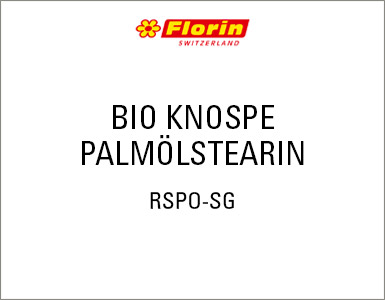
| Energy 3700 kJ (900 kcal) | |
| Protein | 0 g |
| Carbohydrates | 0 g |
| Fat | 100 g |
| Saturated fatty acids | 57 g |
| Monounsaturated fatty acids | 36 g |
| Polyunsaturated fatty acids | 6 g |
| Trans-fatty acids | 0 g |
| Cholesterol | 0 mg |
Palm oil stearin is produced by the physical separation of palm oil into a stearin and an olein phase. Due to its composition, among other things with the saturated fatty acid stearic acid, this fat has a very high melting point.
The fruits of the oil palm are harvested throughout the year.
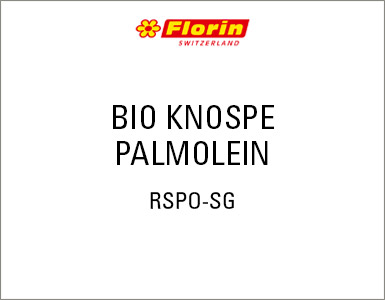
| Energy 3700 kJ (900 kcal) | |
| Protein | 0 g |
| Carbohydrates | 0 g |
| Fat | 100 g |
| Saturated fatty acids | 45 g |
| Monounsaturated fatty acids | 44 g |
| Polyunsaturated fatty acids | 10 g |
| Trans-fatty acids | 0 g |
| Cholesterol | 0 mg |
Palm olein is produced by the physical separation of the stearin phase during palm stearin production. Unlike stearin, the olein phase has a relatively low melting point on account of its predominantly monounsaturated fatty acid chains.
The fruits of the oil palm are harvested throughout the year.




